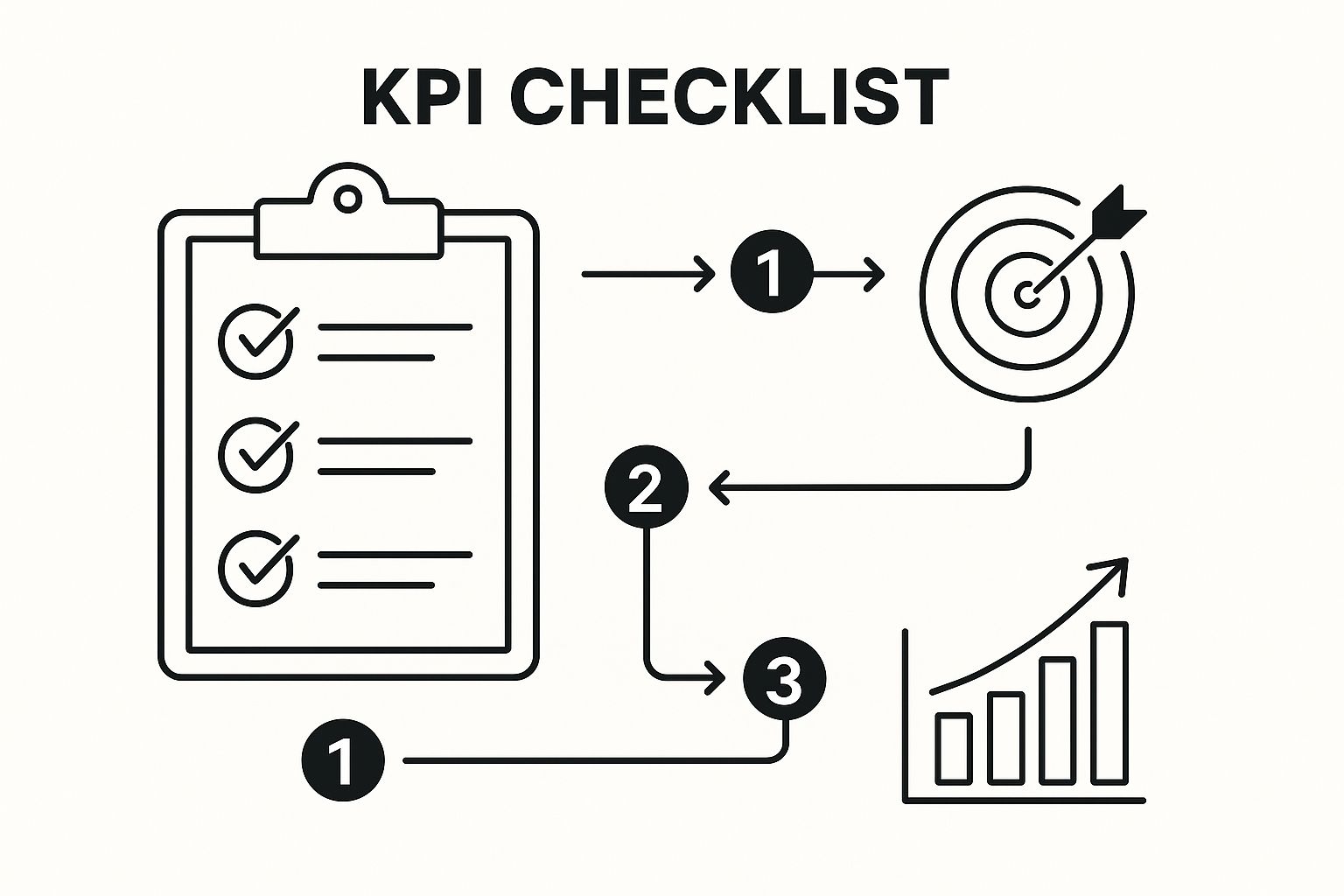If you’re still relying on a basic (Revenue – Cost) / Cost formula to measure your marketing return, you’re flying blind. It’s like trying to navigate the open ocean with just a compass; sure, it points you in a general direction, but you’re completely missing the currents, winds, and tides that actually determine your journey.
That old-school calculation gives you a quick snapshot, but it’s dangerously incomplete. It tells you nothing about the health of your customer relationships, which are the real engine of sustainable growth.
Modern marketing is about building a loyal community, not just landing one-off sales. The traditional formula simply can’t tell the difference between a low-value, one-time buyer and a high-value advocate who keeps coming back. That’s a massive blind spot.
Shift Your Focus to Customer Lifetime Value
To get a real grip on your marketing’s performance, you have to bring Customer Lifetime Value (CLV) into the picture. CLV estimates the total amount of money you can expect to earn from a single customer over the entire course of their relationship with your brand. It completely changes the game, shifting your perspective from a single transaction to a long-term strategic partnership.
When you start tracking CLV, you can confidently make marketing investments that might look questionable on paper at first. Think about a solid content marketing strategy. It could easily take six months to start generating qualified leads, meaning it’s in the red from an immediate ROI perspective. But if those leads turn into customers with a high CLV, the long-term return isn’t just positive—it’s transformative.
It all boils down to this: A customer you acquire today for $50 who ends up spending $500 with you over the next three years is infinitely more valuable than a customer you got for $10 who only ever spends $15. A standard ROI calculation can’t spot that difference.
The Financial Case for a Deeper Look at ROI
Moving beyond surface-level metrics isn’t just an academic exercise; it has a direct impact on your bottom line.
Let’s look at the numbers. The basic formula is simple enough: (Revenue – Cost) ÷ Cost. If you spend $2 to make $10, you’ve got a 400% ROI. Not bad.
But what happens when we bring in CLV? A common way to calculate it is (Annual Revenue × Customer Relationship in Years) – Customer Acquisition Cost. A customer who brings in $100 a year for 10 years, and cost you $200 to acquire, has a CLV of $800. Suddenly, that $200 acquisition cost looks like a brilliant investment.
Getting a handle on these advanced metrics gives you the confidence to spend smarter. I’ve seen a brand increase its marketing budget by 22% without hesitation, simply because they had the CLV data to back it up. For a more detailed breakdown, you can explore different ROI calculation models and their impact.
Before we move on, let’s quickly recap the key metrics you should be watching. This table breaks down the essentials, moving from the foundational numbers to more strategic insights that will give you a complete picture of your performance.
Key Metrics for Modern ROI Analysis
| Metric | What It Measures | Why It’s Critical for ROI |
|---|---|---|
| Customer Acquisition Cost (CAC) | The total cost to acquire a single new customer. | The “cost” side of your ROI equation. Keeping this low is crucial. |
| Conversion Rate | The percentage of users who take a desired action (e.g., purchase, sign-up). | Shows how effectively your marketing persuades people to act. |
| Average Order Value (AOV) | The average amount a customer spends per transaction. | Increasing AOV is a direct way to boost revenue from the same number of customers. |
| Customer Lifetime Value (CLV) | The total projected revenue from a single customer over their entire relationship with you. | This is the North Star. It tells you the true long-term value of your acquisitions. |
| Attribution Modeling | Which marketing touchpoints contributed to a conversion. | Helps you understand which channels are actually driving results so you can invest wisely. |
Having these metrics at your fingertips doesn’t just make for better reports; it leads to smarter decisions, more effective campaigns, and ultimately, a much healthier return on every dollar you spend.
Building Your ROI Tracking Infrastructure
If you’re serious about understanding your marketing ROI, you have to move past vague ideas about where customers are coming from. Truly accurate measurement isn’t about guesswork; it’s built on a solid data foundation. Think of it as a connected ecosystem that tells the complete story of your marketing, from the very first click to the final sale. This goes way beyond just installing a tracking pixel—it’s about creating a single source of truth for your business.
It all starts with getting your conversion tracking right. Knowing how many people visit your site is a vanity metric. What you really need to know is how many of them took a meaningful action. That means setting up specific conversion goals in a tool like Google Analytics 4 (GA4).
This checklist gives you a visual of the key pieces you need to put a strong tracking foundation in place.

As the graphic shows, tracking isn’t a one-and-done task. It’s an ongoing process of setting targets, analyzing growth, and keeping a close eye on your key metrics.
Master UTM Parameters for Flawless Attribution
Once your core analytics are humming along, the next layer is getting granular with campaign tracking. This is where Urchin Tracking Module (UTM) parameters come in. These are simple tags you add to the end of your URLs that tell analytics platforms exactly where your traffic came from.
Without them, all your hard work gets dumped into generic buckets like “social” or “direct.” That makes it impossible to measure ROI with any real precision. A disciplined UTM strategy is non-negotiable if you want to see what’s truly working. It’s what allows you to differentiate performance between, say, a highly targeted email campaign and a broad social media ad.
Let’s look at a couple of real-world examples:
- Email Campaign: For a segmented email blast, your UTMs might look like
utm_source=active-subscribersandutm_campaign=q3-product-launch. - Social Media Ad: For a Facebook ad, you could use
utm_source=facebookandutm_campaign=summer-sale-ad-set1.
This level of detail ensures every single click gets attributed correctly. It’s the difference between vaguely knowing that “email works” and knowing with certainty that your “Q3 product launch” campaign drove $15,000 in sales.
Integrate Your CRM to Connect Marketing to Revenue
The final, and most crucial, piece of the puzzle is integrating your marketing platforms with your Customer Relationship Management (CRM) system. This is where the magic really happens, because it connects your marketing spend directly to actual sales revenue.
By syncing your analytics and CRM, you create what’s called a closed-loop reporting system. You can finally see that a lead who came from a specific blog post last quarter just closed a $50,000 deal today. This connection is the ultimate proof of marketing’s contribution to the bottom line.
This integration isn’t just a “nice-to-have.” One of the biggest hurdles marketers face in proving ROI is the disconnect between marketing data (living in platforms like GA4) and sales data (siloed in a CRM like Salesforce or HubSpot). Bridging this gap is absolutely essential.
When you link these systems, you can finally track how marketing-sourced leads move through the entire sales pipeline, from their first touchpoint to a closed-won deal. That complete visibility is the cornerstone of any serious effort to measure ROI effectively.
Calculating ROI for Different Marketing Channels

Trying to apply a single, one-size-fits-all ROI formula across your marketing is a recipe for bad decisions. Every channel has its own rhythm, costs, and timeline for delivering results. If you measure a long-game SEO strategy with the same yardstick as a weekend pay-per-click campaign, you’ll end up with skewed data and a poorly allocated budget.
To get a real sense of what’s working, you have to look at each channel through its own lens. This is the only way to make fair comparisons and discover where your marketing dollars are truly pulling their weight.
Cracking the Code on Email Marketing ROI
Email marketing is famous for its impressive returns, but its real power is often buried in the details. Sure, you can calculate a single ROI for your entire email program, but the most valuable insights come from slicing the data.
Just look at the retail and e-commerce space, where email marketing can deliver a jaw-dropping 45:1 ROI—that’s $45 back for every dollar spent. This gets even better with personalization; a full 94% of marketers say tailoring content directly lifts their sales. And with 60% of emails now opened on mobile devices, a mobile-first design isn’t just a good idea, it’s essential.
To get a truly clear picture, break down your email ROI into smaller pieces:
- Automated Flows: How much revenue are your welcome series, abandoned cart reminders, and post-purchase follow-ups generating compared to their initial setup cost?
- Newsletter Campaigns: What’s the direct revenue from your regular broadcasts to your main list?
- Segment-Specific ROI: Analyze campaigns sent to hyper-targeted groups, like your VIP customers or first-time buyers.
This kind of granular view can be eye-opening. You might find that while your general newsletter performs okay, your abandoned cart sequence is an absolute profit machine, telling you exactly where to invest more time and resources.
Attributing Value to SEO and Content Marketing
SEO is a different beast altogether. Its impact builds over time and often doesn’t lead to a direct, immediate sale, making ROI a bit tricky to pin down. You can’t just compare last month’s spend to last month’s revenue and call it a day.
A smart way to approach this is by calculating the equivalent paid media cost. Essentially, you figure out how much you would have spent on paid search ads (like Google Ads) to get the same amount of traffic you’re now getting organically. This puts a tangible dollar value on your SEO efforts.
Your ROI formula then looks something like this: (Equivalent Paid Media Cost – SEO Investment) / SEO Investment.
This method helps you justify the steady investment needed for great content and technical SEO, even when you’re dealing with a long sales cycle where direct attribution is a headache.
Differentiating ROAS and ROI in Paid Advertising
When it comes to paid channels like Google Ads or social media advertising, it’s easy to get fixated on Return On Ad Spend (ROAS). It’s a useful metric, but it’s not the same as ROI, and confusing the two can be a costly mistake.
ROAS only tells you the gross revenue generated for every dollar of ad spend. True ROI, on the other hand, forces you to account for all the other costs that go into making that sale happen.
This includes things like:
- Cost of Goods Sold (COGS)
- Agency or freelancer fees
- Software and platform costs
- Expenses for creating ad visuals and copy
Understanding how PPC performance connects to the bottom line is key, and it’s why focusing on measurable results in PPC is so critical for assessing campaign effectiveness.
It’s entirely possible for a campaign to have a fantastic ROAS but a terrible—or even negative—ROI once you factor in all your underlying expenses. Making that distinction is absolutely essential if you want to know whether your paid campaigns are actually driving profit, not just revenue.
Trying to prove the value of your social media efforts can sometimes feel like chasing ghosts. Likes, shares, and follower counts look great on a report, but they don’t directly translate to revenue. To get a real sense of your social media impact, you have to connect the dots between your activity and actual business results.
This means shifting your mindset. Think of your social media channels—whether organic or paid—as powerful tools for sales and lead generation. Every single campaign needs a clear purpose and a reliable way to track its performance. That’s the only way you’ll ever get a true handle on your social media ROI.
From Social Clicks to Sales
The first thing you need to do is build a bridge between what happens on social media and what happens on your website. The most straightforward way to do this is with UTM parameters.
By adding these simple tags to the end of every link you post, you can see exactly which platforms, campaigns, or even specific posts are sending traffic and, most importantly, driving sales. You’ll see all this data neatly organized in your analytics platform, like Google Analytics.
For instance, if you’re promoting a new product in an Instagram Story, your link might have tags like this:
utm_source=instagramutm_medium=socialutm_campaign=fall-product-launchutm_content=story-link
This detailed tracking draws a direct line from a user’s tap on your story to a completed purchase on your site. No more guessing.
Getting Real Numbers from Influencer Campaigns
The same logic applies when you’re working with influencers, but you’ll want to add a couple more layers to your tracking. Don’t just take the influencer’s word for it or rely on their platform’s built-in analytics. Give them the tools they need to show you their real value.
- Unique Discount Codes: This is one of the oldest tricks in the book because it works. Give each influencer their own special code, like PARTNER15. It’s a dead-simple way to track every sale they generate directly.
- Custom UTM Links: Just like with your own posts, create a unique, trackable link for each influencer. They can pop it in their bio, swipe-up stories, or post descriptions. This lets you see the clicks, website sessions, and conversions that came straight from their audience.
Let’s walk through a quick example: Say you partner with a micro-influencer to promote a new skincare line. You give her the discount code SKINGLOW10 and a custom UTM link for her bio. At the end of the campaign, you check your numbers. Her code was used 50 times, bringing in $2,500 in revenue. On top of that, your analytics show her link was responsible for 200 new email subscribers. Now you’re not just guessing—you have hard data to calculate your return.
The Impact of Video and User-Generated Content
Let’s be honest, modern social media runs on video and authentic content from real users. It’s an absolute powerhouse for driving sales. Just look at the numbers: research shows that 49% of consumers make a purchase every month based on what they see from influencers.
Short-form video is especially dominant. A whopping 71% of video marketers say it delivers the highest ROI of any format they use. And don’t forget about user-generated content (UGC)—a staggering 90% of shoppers say UGC influences their buying decisions. You can dig deeper into these compelling social media ROI statistics to see just how much consumer behavior has changed.
To measure the ROI of these formats, you have to guide your audience toward a trackable action. For a video, that means a clear call-to-action with a UTM link. For UGC campaigns, it means creating a branded hashtag and encouraging users to share their own content while pointing them to a trackable link in your bio. This is how you turn authentic, human-to-human engagement into business growth you can actually measure.
Turning ROI Data Into Smarter Decisions

Collecting marketing data is one thing. Actually using it to make better, faster, and more profitable decisions is another game entirely. The real magic happens when you move past simply reporting on what happened and start using those numbers to dictate your next move.
This is where you shift from being a reactive marketer to a proactive strategist. It all starts by digging into your campaigns to see what’s truly working. You’re looking for the channels, messages, and audiences that deliver the most bang for your buck.
It’s not always about the campaign with the biggest revenue number attached. For instance, you might find that a scrappy, low-cost organic social campaign brought in fewer leads than your big-budget paid search ads. But if those organic leads converted at a much higher rate, your actual cost to acquire a customer was lower. That’s a massive win and an opportunity you can’t afford to ignore.
Uncovering The Full Customer Journey With Attribution
To get a true read on performance, you have to look beyond the last thing a customer clicked. The path to purchase is almost never a straight line. People bounce around, interacting with your brand across different channels before they finally commit.
Giving 100% of the credit to the last touchpoint is like only thanking the closer on a sales team—it ignores all the hard work that warmed up the lead in the first place.
Here’s a quick breakdown of the most common ways to look at this:
- First-Touch Attribution: This gives all the credit to the very first interaction. It’s perfect for figuring out which channels are your best discovery engines.
- Last-Touch Attribution: The opposite of first-touch, this assigns 100% of the credit to the final click before a conversion. It’s solid for identifying what pushes people over the finish line.
- Multi-Touch Attribution: This is where the nuanced, actionable insights live. Models like linear, time-decay, or U-shaped spread the credit across multiple interactions, giving you a more holistic and realistic view of what’s driving your success.
By looking at the journey through a multi-touch lens, you see how all your channels play together. You might discover your blog posts are the handshake, your email newsletter is the conversation, and your retargeting ads are what finally seal the deal.
From Insights To Action: A Quarterly Review Framework
Once you have this richer understanding, you can start making confident decisions backed by real data. A quarterly ROI review is one of the most effective habits you can build. It keeps your team nimble and ensures you’re not just running on assumptions.
In these review sessions, focus your discussion around a few critical questions:
- Which campaigns beat their ROI goals, and what made them successful?
- Which ones missed the mark, and what can we learn from the miss?
- Looking at this data, how should we shift our budget for the next quarter?
- Can we spot any trends to help us forecast future results more accurately?
This disciplined, regular check-in forces you to constantly move your resources toward what’s most profitable. This systematic approach is critical, as allowing for data-driven decision-making is the key to continuous optimization in any field.
Ultimately, this process turns your ROI data from a simple report card into a strategic roadmap, proving your team’s value and guiding every marketing dollar you spend.
Common Questions About Measuring Marketing ROI
Once you start getting serious about measuring marketing ROI, you’ll quickly realize that the standard formulas don’t always cover real-world situations. What do you do when a campaign won’t show a return for six months? How do you possibly assign a dollar value to something as fuzzy as brand awareness?
Let’s dive into these common—and frankly, complex—questions. Figuring out how to handle them is critical. If you don’t, you risk undervaluing your most important long-term strategies and making budget cuts based on an incomplete picture of your marketing’s true impact.
How Do You Handle Long B2B Sales Cycles?
This is one of the biggest headaches for B2B marketers. When a deal takes anywhere from 6 to 12 months to close, trying to connect today’s sale to a blog post someone read nine months ago feels like a guessing game. It’s tough, but it’s not impossible.
The trick is to shift your thinking away from immediate, direct-response ROI. Instead, you need to focus on measuring pipeline influence.
Stop asking only, “Did this campaign make a sale this month?” and start asking better questions:
- How many marketing-qualified leads (MQLs) did this campaign bring in?
- Did it spark new, tangible opportunities in our CRM?
- How does the sales velocity for these leads compare to leads from other channels?
Focusing on these leading indicators allows you to prove a campaign’s value long before the revenue actually hits the books. It’s how you justify sustained investment in long-game strategies like content marketing and SEO.
The goal is to show how marketing is filling and accelerating the sales pipeline. When you can demonstrate that a specific campaign consistently produces high-quality opportunities, you’ve built a strong case for its ROI, regardless of the sales cycle’s length.
Can You Measure ROI for Brand Awareness?
Putting a number on brand awareness can feel like trying to nail Jell-O to a wall. But it’s absolutely essential for sustainable growth. While you can’t always draw a perfectly straight line from a brand campaign to a specific sale, you can track metrics that are directly correlated with the health of your business.
Think about it this way: companies with strong employer brands have been shown to reduce employee turnover by as much as 28% and cut their cost-per-hire by up to 50%. Those are real, hard numbers that go straight to the bottom line.
To get a handle on your brand-building efforts, start monitoring metrics like these:
- Direct and Branded Search Traffic: Are more people actively looking for you by name? That’s a great sign.
- Social Media Engagement and Mentions: Is the conversation around your brand growing?
- Earned Media Value (EMV): What’s the equivalent advertising cost of the press mentions and unpaid features you’re getting?
Tracking these gives you concrete data to show that your brand-building isn’t just “fluff”—it’s creating tangible business value. For a more detailed breakdown, this guide on how to measure marketing campaign success is a great resource that covers frameworks for tracking both direct and indirect results.
Ready to stop guessing and start proving your marketing’s impact? The team at ReachLabs.ai takes a data-driven approach, combining expert strategy with precise execution to deliver measurable results. Let’s build a strategy that moves the needle for your business.





